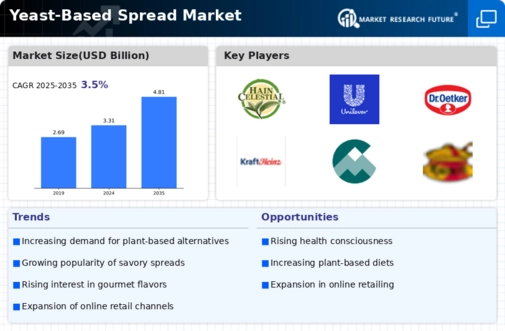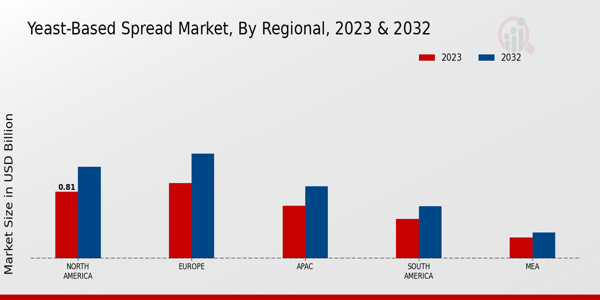Sustainability Trends
Sustainability is becoming a pivotal driver in the Global Yeast-Based Spread Market Industry, as consumers increasingly prioritize environmentally friendly products. The production of yeast-based spreads often involves lower carbon footprints compared to traditional spreads, appealing to eco-conscious consumers. Brands that emphasize sustainable sourcing and packaging are likely to gain a competitive edge. This trend aligns with the broader movement towards sustainable food systems, which is expected to influence purchasing decisions significantly. As the market evolves, companies that adopt sustainable practices may see enhanced brand loyalty and market share, contributing to the overall growth of the industry.
Market Growth Projections
The Global Yeast-Based Spread Market Industry is poised for substantial growth, with projections indicating a rise from 3.31 USD Billion in 2024 to 4.81 USD Billion by 2035. This growth trajectory suggests a compound annual growth rate of 3.46% from 2025 to 2035. Such figures reflect the increasing consumer interest in yeast-based spreads, driven by health trends, innovative product offerings, and sustainability considerations. As the market evolves, it is essential for stakeholders to monitor these trends closely, as they will likely shape the competitive landscape and influence future product development strategies.
Rising Health Consciousness
The Global Yeast-Based Spread Market Industry is witnessing a surge in demand driven by increasing health consciousness among consumers. As individuals become more aware of the nutritional benefits associated with yeast-based spreads, such as their high protein content and essential vitamins, the market is expected to grow significantly. This trend is particularly evident in regions where consumers are shifting towards plant-based diets. The market is projected to reach 3.31 USD Billion in 2024, reflecting a growing preference for healthier alternatives. This shift not only enhances the appeal of yeast-based spreads but also aligns with broader dietary trends emphasizing natural and wholesome ingredients.
Innovative Product Development
Innovation plays a crucial role in the Global Yeast-Based Spread Market Industry, as manufacturers continuously explore new flavors and formulations to attract diverse consumer segments. The introduction of unique variants, such as those infused with herbs, spices, or even superfoods, caters to evolving taste preferences. This creative approach not only enhances product offerings but also encourages trial among consumers. As a result, the market is likely to expand, with projections indicating a growth to 4.81 USD Billion by 2035. Such innovations are essential for maintaining competitiveness in a rapidly changing food landscape, where consumer expectations are increasingly sophisticated.
Growing Vegan and Vegetarian Population
The rise in the vegan and vegetarian population is a notable driver for the Global Yeast-Based Spread Market Industry. As more individuals adopt plant-based diets for health, ethical, or environmental reasons, the demand for yeast-based spreads, which are inherently vegan, is likely to increase. This demographic shift is particularly pronounced in urban areas, where consumers are more exposed to diverse dietary options. The market's growth trajectory suggests a compound annual growth rate of 3.46% from 2025 to 2035, indicating that yeast-based spreads will play a crucial role in meeting the needs of this expanding consumer base.
Increased Availability in Retail Channels
The Global Yeast-Based Spread Market Industry is benefiting from enhanced availability through various retail channels. Supermarkets, health food stores, and online platforms are increasingly stocking yeast-based spreads, making them more accessible to consumers. This increased distribution is essential for capturing a broader audience, as convenience plays a significant role in purchasing decisions. The proliferation of e-commerce has further facilitated access to these products, allowing consumers to explore and purchase a variety of yeast-based spreads from the comfort of their homes. This trend is likely to contribute to the market's growth as it reaches new consumer segments.























Leave a Comment